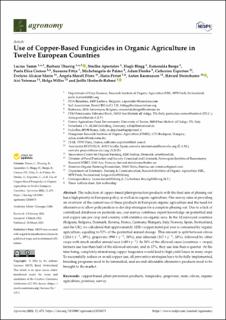Use of Copper-Based Fungicides in Organic Agriculture in Twelve European Countries
| dc.contributor.author | Tamm, Lucius | |
| dc.contributor.author | Thuerig, Barbara | |
| dc.contributor.author | Apostolov, Stoilko | |
| dc.contributor.author | Blogg, Hugh | |
| dc.contributor.author | Borgo, Esmeralda | |
| dc.contributor.author | Corneo, Paola Elisa | |
| dc.contributor.author | Fittje, Susanne | |
| dc.contributor.author | de Palma, Michelangelo | |
| dc.contributor.author | Donko, Adam | |
| dc.contributor.author | Experton, Catherine | |
| dc.contributor.author | Marin, Évelyne Alcázar | |
| dc.contributor.author | Pérez, Ángela Morell | |
| dc.contributor.author | Pertot, Ilaria | |
| dc.contributor.author | Rasmussen, Anton | |
| dc.contributor.author | Steinshamn, Håvard | |
| dc.contributor.author | Vetemaa, Airi | |
| dc.contributor.author | Willer, Helga | |
| dc.contributor.author | Herforth-Rahmé, Joëlle | |
| dc.date.accessioned | 2022-07-11T09:18:54Z | |
| dc.date.available | 2022-07-11T09:18:54Z | |
| dc.date.created | 2022-03-10T15:45:22Z | |
| dc.date.issued | 2022-03-10 | |
| dc.identifier.citation | Agronomy. 2022, 12 (3), . | en_US |
| dc.identifier.issn | 2073-4395 | |
| dc.identifier.uri | https://hdl.handle.net/11250/3004504 | |
| dc.description.abstract | The reduction of copper-based plant-protection products with the final aim of phasing out has a high priority in European policy, as well as in organic agriculture. Our survey aims at providing an overview of the current use of these products in European organic agriculture and the need for alternatives to allow policymakers to develop strategies for a complete phasing out. Due to a lack of centralized databases on pesticide use, our survey combines expert knowledge on permitted and real copper use per crop and country, with statistics on organic area. In the 12 surveyed countries (Belgium, Bulgaria, Denmark, Estonia, France, Germany, Hungary, Italy, Norway, Spain, Switzerland, and the UK), we calculated that approximately 3258 t copper metal per year is consumed by organic agriculture, equaling to 53% of the permitted annual dosage. This amount is split between olives (1263 t y−1, 39%), grapevine (990 t y−1, 30%), and almonds (317 t y−1, 10%), followed by other crops with much smaller annual uses (<80 t y−1). In 56% of the allowed cases (countries × crops), farmers use less than half of the allowed amount, and in 27%, they use less than a quarter. At the time being, completely abandoning copper fungicides would lead to high yield losses in many crops. To successfully reduce or avoid copper use, all preventive strategies have to be fully implemented, breeding programs need to be intensified, and several affordable alternative products need to be brought to the market. | en_US |
| dc.description.abstract | Use of Copper-Based Fungicides in Organic Agriculture in Twelve European Countries | en_US |
| dc.language.iso | eng | en_US |
| dc.publisher | MDPI, Basel, Switzerland | en_US |
| dc.rights | Navngivelse 4.0 Internasjonal | * |
| dc.rights.uri | http://creativecommons.org/licenses/by/4.0/deed.no | * |
| dc.title | Use of Copper-Based Fungicides in Organic Agriculture in Twelve European Countries | en_US |
| dc.title.alternative | Use of Copper-Based Fungicides in Organic Agriculture in Twelve European Countries | en_US |
| dc.type | Peer reviewed | en_US |
| dc.type | Journal article | en_US |
| dc.description.version | publishedVersion | en_US |
| dc.rights.holder | © 2022 by the authors | en_US |
| dc.source.pagenumber | 21 | en_US |
| dc.source.volume | 12 | en_US |
| dc.source.journal | Agronomy | en_US |
| dc.source.issue | 3 | en_US |
| dc.identifier.doi | 10.3390/agronomy12030673 | |
| dc.identifier.cristin | 2008895 | |
| dc.relation.project | EC/H2020/773431 | en_US |
| dc.source.articlenumber | 673 | en_US |
| cristin.ispublished | true | |
| cristin.fulltext | original | |
| cristin.qualitycode | 1 |
Tilhørende fil(er)
Denne innførselen finnes i følgende samling(er)
-
Divisjon for matproduksjon og samfunn [1012]
Publikasjoner knyttet til ansatte ved Divisjon for matproduksjon og samfunn -
Publikasjoner fra CRIStin - NIBIO [4532]
-
Vitenskapelige artikler [1416]

